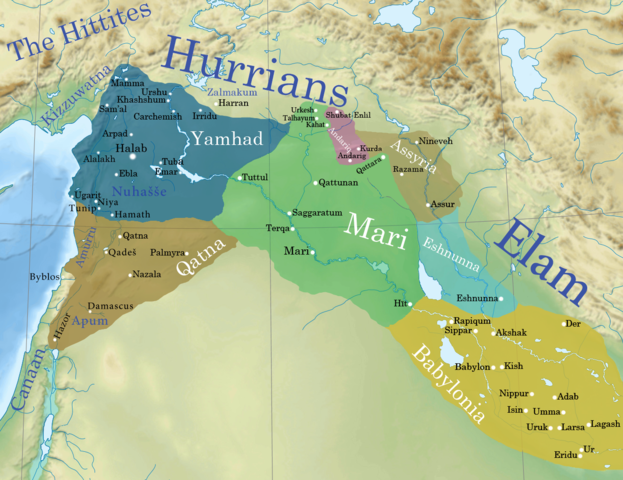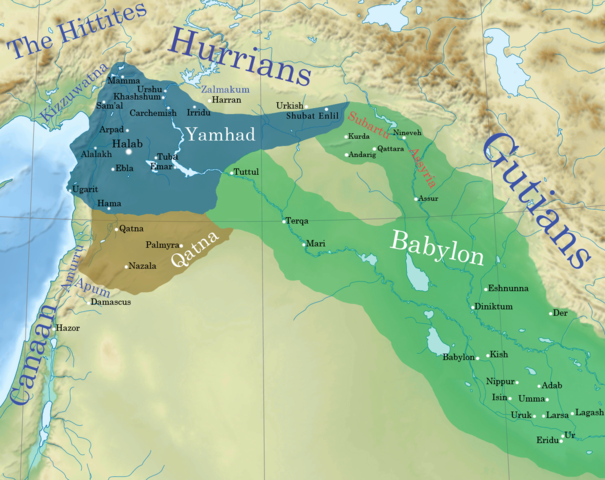
| SHAMSHI-ADAD - I
Line-drawing of an incomplete seal of Shamshi-Adad I
King
of Upper Mesopotamia
Succeeded by : Ishme-Dagan I (Assur and Ekallatum) Yasmah-Adad (Mari)
Regnal
titles of Shamshi-Adad I : King of the Universe, Pacifier
of the Land between Tigris and Euphrates
Shamshi-Adad (Akkadian: Šamši-Adad; Amorite: Shamshi-Addu), ruled c. 1808–1776 BC, was an Amorite warlord and conqueror who had conquered lands across much of Syria, Anatolia, and Upper Mesopotamia.
Rise :
A map of the Ancient Near East showing the geopolitical situation around the Kingdom of Upper Mesopotamia (light brown) near contemporary great powers such as: Eshnunna (light blue), Yamhad (dark blue), Qatna (dark brown), the First Dynasty of Babylon (yellow), and the Third Mariote Kingdom (shortly before the conquest of the long-abandoned town of Šubat-Enlil c. 1808 BC by the Amorite conqueror Šamši-Adad I.)
Shamshi-Adad I inherited the throne in Ekallatum from Ila-kabkabu (fl. c. 1836 BC – c. 1833 BC). Ila-kabkabu is mentioned as the father of Shamshi-Adad I in the "Assyrian King List" (AKL); a similar name (not necessarily the same figure) is listed in the preceding section of the AKL among the “kings whose fathers are known”. However, Shamshi-Adad I did not inherit the Assyrian throne from his father but was instead a conqueror. Ila-kabkabu had been an Amorite king not of Assur (Aššur) (in Assyria) but of Ekallatum. According to the Mari Eponyms Chronicle, Ila-kabkabu seized Shuprum (c. 1790 BC), then Shamshi-Adad I “entered his father's house” (Shamshi-Adad I succeeded Ila-kabkabu as the king of Ekallatum, in the following year.) Šamši-Adad I had been forced to flee to Babylon (c. 1823 BC) while Naram-Sîn of Eshnunna (fl. c. 1850 BC – c. 1816 BC) had attacked Ekallatum. Shamshi-Adad I had remained in exile until the death of Naram-Sin of Eshnunna (c. 1816 BC.) The AKL records that Shamshi-Adad I "went away to Babylonia in the time of Naram-Sin". Shamshi-Adad I did not return until retaking Ekallatum, pausing for some time, and then overthrowing King Erishum II of Assur (fl. c. 1818 BC – c. 1809 BC) Shamshi-Adad I conquered Assur and emerged as the first Amorite king of Assyria (c. 1808 BC).
Although regarded as an Amorite by later Assyrian tradition, earlier archaeologists assumed that Shamshi-Adad I had indeed been a native Assyrian. Usha was the second last in the section "kings who lived in tents" of the AKL, however; Ushpia has not been confirmed by contemporary artifacts. Ushpia is succeeded on the AKL by his son Apiashal. Apiashal was a monarch of the Early Period of Assyria, according to the AKL. Apiashal is listed within the section of the AKL as the last of whom "altogether seventeen kings, tent dwellers". This section shows marked similarities to the ancestors of the First Babylonian dynasty. Apiashal is also listed within a section of the AKL as the first of the ten "kings whose fathers are known". This section (which in contrast to the rest of the list) had been written in reverse order—beginning with Aminu and ending with Apiashal "altogether ten kings who are ancestors"—has often been interpreted as the list of ancestors of Shamshi-Adad I. In keeping with this assumption, scholars have inferred that the original form of the AKL had been written (among other things) as an "attempt to justify that Shamshi-Adad I was a legitimate ruler of the city-state Assur and to obscure his non-Assyrian antecedents by incorporating his ancestors into a native Assyrian genealogy". However, this interpretation has not been accepted universally; the Cambridge Ancient History rejected this interpretation and instead interpreted the section as being that of the ancestors of Sulili.
In the city-state Assur, Shamshi-Adad I held the title "Governor of Assur". Stone tablets with Akkadian inscriptions (formatted in three columns and one hundred and thirty-five lines, from Shamshi-Adad I) have been found near the temple of the god Assur. Many bricks and objects inside the temple have the inscription "Shamshi-Adad I, Builder of the Temple of Assur" carved into them. In this inscription he claimed to have been "King of the Universe" and "Unifier of the Land Between Tigris and Euphrates". He asserted that the king of the Upper Land had paid tribute to him and that he had built the temple of Enlil. He outlined the market prices of that time as being one shekel of silver being worth two kors of barley, fifteen minas of wool, or two seahs of oil.
Conquests
:
King Dadusha of Eshnunna (fl. c. 1800 BC – c. 1779 BC), made an alliance with Shamshi-Adad I to conquer the area between the two Zab rivers c. 1781 BC. This military campaign of joint forces was commemorated on a victory stele which states that Dadusha gave the lands to Shamshi-Adad I. Shamshi-Adad I later turned against Dadusha by attacking cities including Shaduppum, Nerebtum and Andarig. On inscriptions Shamshi-Adad I boasts of erecting triumphal stelae on the coast of the Mediterranean, but these probably represent short expeditions rather than any attempts at conquest. His campaigns were meticulously planned, and his army knew all the classic methods of siegecraft, such as encircling ramparts and battering rams. The 5th year name of Dadusha's son and successor, Ibal-pi-el II records the death of Shamshi-Adad.
Family
:
"Are you a child, not a man, have you no beard on your chin?"
Shamshi-Adad I wrote in another letter:
"While here your brother is victorious, down there you lie about among the women."
Shamshi-Adad I clearly kept a firm control on the actions of his sons, as shown in his many letters to them. At one point he arranged a political marriage between Yasmah-Adad to Beltum, the princess of his ally in Qatna. Yasmah-Adad already had a leading wife and had put Beltum in a secondary position of power. Shamshi-Adad I did not approve and forced his son to keep Beltum in the palace in a leading position.
Shamshi-Adad I sent a letter on a tablet to Ishi-Addu (Beltum's father, the King of Qatna) in which he discussed their alliance, the attacks of their enemies, and the successful marriage between their children. In it Shamshi-Adad I wrote:
"I heard that you gladly dispatched my daughter-in-law on a safe way back to me, that you treated my servants when they stayed with you well, and that they were not hindered at all. My heart is very happy."
Reign
:
Fall :
A
map of the Ancient Near East showing the geopolitical situation
around Assyria near contemporary great powers such as: Yamhad (dark
blue) and Qatna (dark brown), after the conquests of Hammurabi of
the First Dynasty of Babylon (green) c. 1750 BC.
Source :
https://en.wikipedia.org/ |


